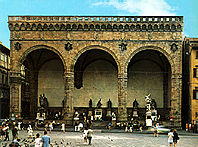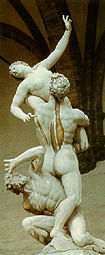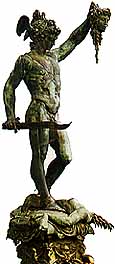
Orcagna, Loggia of the Lanzi
Excusez nous mais cette page n'est pas été encore traduite en Français
The Loggia dei Lanzi, built between 1376 and 1382 to house the assemblies of the people and hold public ceremonies like, for example, the swearing into office of the Gonfaloniers and the Priors, stands on the righthand corner of Palazzo Vecchio, where Piazza della Signoria meets the square of the Uffizi. It was in fact originally called the Loggia della Signoria or "of Orcagna", from the name of the artist who designed it (though it was actually carried out by Benci di Cione and Simone Talenti). During Cosimo I's reign, it was used to house the Duke's Lasquenets or German mercenary troups, from whom it eventually took its name.
After the construction of the Uffizi, which was built onto the rear of the Loggia, Bernardo Buontalenti transformed the terrace into a sort of hanging garden (1583) from which the princes could watch ceremonies or performances in the square. The first intervention of restoration was carried out by Pasquale Poccianti between 1837-40.
The medallions on the facade of the Loggia contain the allegorical figures of the Virtues by Agnolo Gaddi (1383-86). Two lions stand beside the steps, one of them dates from Roman times while the other is by Flaminio Vacca (1600).

The
sculptures under the Loggia
Today we can admire a series of classical and Mannerist sculptures, as well as a 19th century Rape of Polyxena (Pio Fedi, 1866), beneath the elegant and early Renaissance style arches of the Loggia. The classical sculptures include a group of six female figures, considerably touched up, and the Menelaus holding up the body of Patroclus (restored by Stefano Ricci). The Mannerist groups of sculpture are particularly important: these include the extremely beautiful Rape of the Sabines (1583, the cast is in the Academy Gallery) and Hercules fighting the centaur Nessus (1599), both of them by Giambologna. However the Perseus with the head of the Medusa is the finest work there, Benvenuto Cellini's extraordinary masterpiece in bronze(1545-54), recently restored.

Giambologna,
Rape of the Sabines
The artist was given the commission to carry out the Perseus, which can be seen below the lefthand arch, in 1545, immediately after his return from Paris, by Cosimo I. Three years later, however, after having seen a life side model of the sculpture, the Duke tried to put Cellini off completing it because he was convinced that it would be impossible to cast it with the head of the Medusa hanging from the hands of Perseus.

Cellini,
Perseus with the
head of Medusa
Cellini was in fact careful to keep this fairly close to the body and, after several attempts, which can be read about in his memoires, he managed to complete the epic cast by throwing all his pots and pans into the furnace and feeding the flames with his household furniture. He carried out the four statuettes in the niches of the pedestal (Jove, Mercury, Minerva and Danae) and the bas-relief with Perseus freeing Andromeda later, in 1552. Nine years after being commissioned, in 1554, the Perseus was exhibited under the Loggia and was immediately acclaimed by the whole city.
